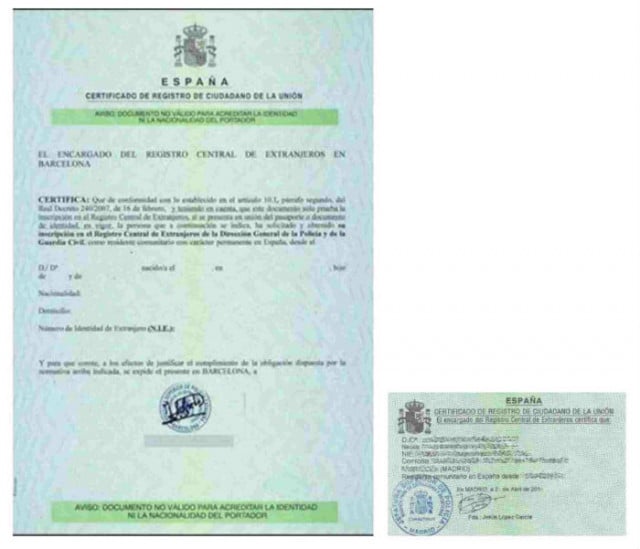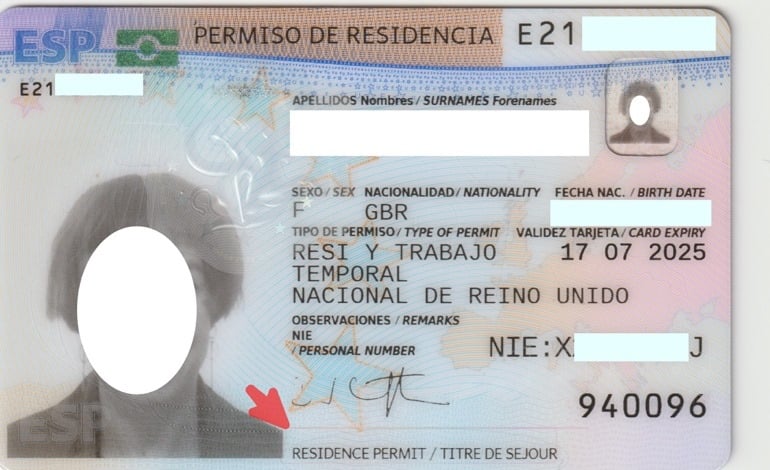What is a TIE?
On July 6th, UK citizens registering as residents in Spain started to be issued with the highly anticipated TIE residence cards.
A TIE is a “Tarjeta de Identidad de Extranjero”, an identity card for foreigners which is issued to non-EU residents in Spain.
Although the document may be a reminder for Britons in Spain that they will soon cease to be EU citizens, the TIE also acts as a guarantee that they will hold on to the same rights relating to residency, free movement and social security in the country they’ve made their home.
“Spain appears to be faithfully reflecting the requirements of the Withdrawal Agreement,” Nigel Aston, head of EuroCitizens group, told The Local.
These rights will be guaranteed for their family members, even those from non-EU countries, as long as they are already registered or do so before December 31st 2020.
Who needs to get a TIE?
UK citizens who have not registered as residents in Spain but intend to carry on living in the country after December 31st (for more than 90 days over a 180-day period) will have to get a TIE.
After July 6th 2020, any UK citizen applying for residence in Spain will be issued this biometric TIE card if they meet the requirements.
For UK citizens who have registered as residents in Spain and are already in possession of a green A4 residency certificate or a small green residency card, the TIE card is optional.
Despite this, many British residents in Spain have chosen to replace their green residency certificates with TIEs since they began to be issued in early July (scroll down to find out more).
READ ALSO:
- BREXIT: Brits in Spain offered help with residency applications
- A message to Brits in Spain from the ambassador and Spanish authorities
- Moving to Spain: What's the difference if I move before or after December 31st?
 Photo: AFP
Photo: AFP
When should non-residents get a TIE?
If you’re a UK citizen who lives in Spain but you haven’t registered as a resident before, you should begin the application for a TIE as soon as possible if you intend to carry on living in the country after December 31st 2020 (for more than 90 days over a 180-day period).
This has been the advice from every official group fighting for the rights of Britons in Spain post-Brexit, from the British Embassy to the Citizens Advice Bureau Spain.
Equally if you are a UK citizen who is planning to move to Spain, it is highly recommendable you do so before the end of the Brexit transition period and apply for a TIE, as your rights as a resident in Spain will be protected under the Withdrawal Agreement.
READ MORE: What's the difference if I move to Spain before or after December 31st?
You will still be able to apply for a TIE residence card after Brexit but these rights will not be automatically guaranteed and the set of requirements needed to be issued with the card are likely to be stricter and closer to those for third-country nationals in Spain.
However, immigration offices will assess the circumstances and the reasons for this non-compliance and will grant the UK citizen an additional period long enough to submit the application if the reasons for the non-compliance are well founded.
UK citizens who intend to register in Spain after Brexit will have to apply within the first three months of their arrival, in accordance with the provisions set out in the Withdrawal Agreement.
When should British residents in Spain get a TIE?
This has been the subject of much debate recently among Britons who already have a green residency document.
For UK citizens who are already residents in Spain, the official message from the British Embassy is that the TIE card is optional.
“While you may choose to change your current certificate for a TIE at some point in the future, there's no requirement to do so,” British Ambassador to Spain Hugh Elliott clarified.
The BOE bulletin by the Spanish government which announced the launch of the TIE also confirmed this by stating that Brits who are already registered in Spain “will not have the obligation to apply for a new resident status nor, therefore, undergo a new documentation process, but they will have the right to receive a residence document that expressly reflects their status as a beneficiary of the Withdrawal Agreement”.
“If you choose to do it, leave it till after December 31st,” Anne Hernández, head of Brexpats in Spain, told The Local.
“Those who are desperately trying to get their TIEs for the first time and benefit from the Withdrawal Agreement are very stressed because appointments are few and far between.
“It seems rather selfish to do it now, thereby further reducing availability of appointments before the end of the transition period.
“So think of your fellow Brits and wait till 2021 if you wish to exchange your green residency for the TIE but there is no obligation to exchange it.”
However, as it is fundamentally a personal decision, many British residents in Spain are choosing to apply for a TIE now.
Mark Stucklin of Spanish Property Insight recently wrote an opinion piece on his website titled “British residents in Spain, don’t forget to apply for your TIE (Foreigner’s ID) card this year, just to be on the safe side”, in which he explained why he chose to apply for the card as “you never know what’s around the next corner with Brexit, so better safe than sorry”.
Nigel Aston, President of EuroCitizens, a lobbying group which fights for the rights of British residents in Spain told The Local: “Holders of green cards/A4 papers can retain those as an alternative to the TIE, at the moment, in perpetuity.
“That may change in the future but the Spanish have, as yet, given no contrary indication.
“Nevertheless, the EuroCitizens' advice is to get a TIE.
“(Given the Spanish government’s stance) there is no rush but we recommend doing it for convenience reasons and, more fundamentally, as it confers status.”
Is a TIE card better than the old, green residency certificate?
“I think it is worth emphasising that the advantage of the TIE as envisaged in the BOE is that it clearly states that the holder is entitled to the rights set out in the Withdrawal Agreement and distinguishes between initial residency and permanent,” Aston told The Local.
“The TIE for registered UK citizens living in Spain at 31 December is annotated to show that the holder is “protected” by the citizens' rights provisions of the Withdrawal Agreement.
“Whilst most officials in the Spanish administration and, indeed, counterparts in other Schengen states will recognise this protection in the passport/green docs, probably some will not, potentially causing bureaucratic issues.
“Holding the appropriate TIE, therefore, is a clear, unambiguous, confirmation of ongoing rights.”
From a practical standpoint, the TIE is a hard, laminated card that is certainly more durable than the old A4 residence paper certificate (seen below on the left).
 It will also be small enough to fit in a wallet and will serve as photo ID, something that the smaller credit-card sized green residence cards can't offer.
It will also be small enough to fit in a wallet and will serve as photo ID, something that the smaller credit-card sized green residence cards can't offer.
What is the process for applying for a TIE?
Given the different elements and requirements to keep in mind for each application, we have dedicated this separate article to the TIE process.
The standout requirements are the need to prove that you have sufficient financial resources not to be a burden to the State and to have healthcare cover either through work, a pension, a pay-in scheme or private cover which is equivalent to Spain’s public healthcare services.
Is it true there are mistakes on some of the new TIE cards?
Correct. Many Britons who have received their new residency cards in Spain have noticed that they contain information which isn't accurate.
“Some of the new TIEs obtained via the EX23 route (those who already had a green residency and just wanted to exchange them for the TIE) have picked their cards up from several different areas of Spain but they are wrongly worded,” Anne Hernandez, head of the Brexpats in Spain organisation, told The Local.
The biometric cards, which should have the wording at the bottom saying “Residence Permit/Titre de Sejour” instead state “family member of a Union citizen”.

“Although they say ‘issued in accordance with the Withdrawal Agreement' they also say a family member of an EU citizen,” Hernández said.
In theory, this would suggest that the residency card was obtained by being a spouse or a family member of a Spanish or other EU citizen, rather than it being a British person who has obtained the card in their own right by residing in Spain before December 31st 2020.
“Some of the TIEs are also wrongly dated,” Hernandez adds.
“A permanent TIE card should be 10 years but it seems they are being dated to expire in 5 years”.
The official advice is to check to your TIE card as soon as you get it for these mistakes and notify the police station there and then.
“The Spanish authorities have confirmed that, despite the inscription, these TIEs remain valid and we are waiting for instructions on how you should exchange this card for the correct one,” The British Embassy said.
READ MORE: What we know about the two mistakes on the new TIE residency cards
What happens if I can't get an appointment before December 31st 2020?
Britons applying for TIEs currently are also having difficulties getting appointments.
“We know that it is still difficult to get residency appointments in many areas,” the British Embassy confirmed in mid-October.
“Anyone who is struggling to obtain an appointment should make sure they have all the documentation necessary for their application and to prove that they are legally living in Spain by the end of this year.
Numerous other sources, including the Spanish government, have confirmed this backlog in residency applications at migration offices (Extranjería) across Spain.
According to the Moncloa government website, “Spain's government has been working continuously for months to optimise the appointments system.
The immigration offices and police stations of the provinces where most British citizens live have been equipped with more personnel and material means to be able to respond to the increase in the demand for residence certificates.”
The government site also points out that some police stations don't use the online “cita previa” appointment system and have to be contacted by phone, although there are many complaints from residency applicants from not just the UK who said they've been unable to reach police stations on the numbers they provide.
Coronavirus restrictions have only served to further limit communication with public administrations as many of them have been fully or partially closed and haven’t allowed “citas previas” for many other official affairs other than TIE applications.
If all else fails, the best option is to head to your closest migration office in person to explain the situation and try to obtain some sort of reference code which states that you applied before December 31st 2020.
It is also recommendable to contact a “gestor” as they can often get appointments at Spain’s public administrations when others can’t.
How long will the TIE residency card be valid for?
TIE cards will be valid for either five years or ten years, depending on how long the UK citizen has been living in Spain.
Registered foreign residents of Spain can apply for permanent residency after five years, which means that if you’ve been living in Spain for that time or more your TIE card will be valid for ten years.
What if I’ve registered as a resident in Spain but I’m not there when Brexit officially happens?
The Withdrawal Agreement does not require the physical presence of UK residents of Spain at the end of the transitional period on December 31st.
Any temporary absences that do not affect the right of residence outside Spain must be accepted, in accordance with article 11 of the Withdrawal Agreement.
These absence thresholds are in most cases 6 months for temporary residents who haven’t lived in Spain for more than five years and 2 years for permanent residents who’ve lived in Spain for more than 5 years.
What about if I was issued a green residency document but I haven’t resided in Spain continuously?
Spanish migration authorities say they “will presume that the start of your legal residence in Spain occurred on the date of issuance of the temporary registration certificate”.
That seems to imply that if you received either the green residence certificate or card more than five years ago but haven’t lived in Spain continuously since then, you can still apply for permanent residency in the form of a TIE card valid for ten years.
More information:
Spain's government has produced handy FAQ sheet with all the information about the new process. HERE
Check out the UK Foreign Office latest advice on Living In Spain HERE



 Please whitelist us to continue reading.
Please whitelist us to continue reading.
Member comments